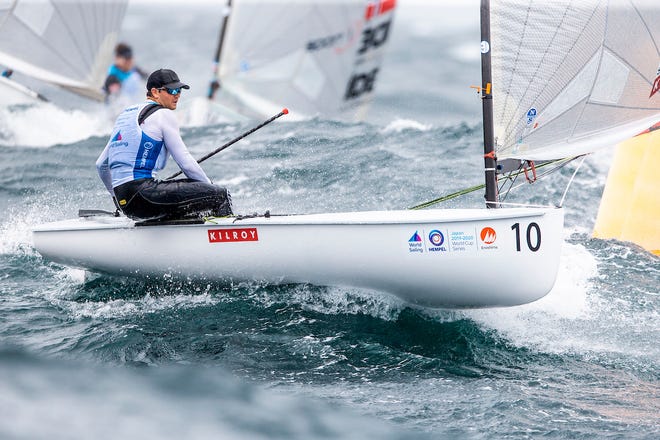
The Tokyo Olympic Games are just a little under a year away, but one group of athletes has already begun its countdown to medal competition.
Recently, U.S. Sailing named 23 members to its team scheduled to compete in 10 sailing events during the games. Earlier this summer, the Tokyo games were postponed to summer 2021 because of the COVID-19 global pandemic.
That doesn’t mean any of these sailors — men and women from a mix of backgrounds, hometowns and levels of experience — have any time to relax. Training plans have been developed and are being executed to give the U.S. team the best chance to medal in Japan next summer.
This Olympic sailing team has a distinctly Florida flavor. Nine of its members are either from Florida or are training here. They are:

- Luke Muller, 24, Fort Pierce, Finn
- Anna Weis, 20, Fort Lauderdale, Nacra 17 with Riley Gibbs, 23, Long Beach, Calif.
- Paige Railey, 33, Clearwater, Laser Radial
- Pedro Pascual, 24, West Palm Beach, RSX windsurfer
- Stephanie Robel, 31, Miami, 49erFX with Maggie Shea, 31, Wilmette, Ill.
- Dave Hughes, 42, Miami, 470 with Stu McNay, 39, Providence, R.I.
- Erika Reineke, 27, Fort Lauderdale, Laser Radial
- Ian Macdiarmid, 22, Delray Beach, 49er
- Meredith Muller Brody, 33, Fort Pierce, Olympic director for U.S. Sailing
Muller and Brody are brother and sister, 9 years apart in age. They both got their start sailing the afternoon prevailing southeasterly breezes on the Indian River Lagoon. Both graduated from Lincoln Park Academy in Fort Pierce and credit former neighbor, two-time windsurfing Olympic medalist Mike Gebhardt with influencing their decision to take to the water.
“My older siblings and I learned how to windsurf the hurricane swells at the jetty with Mike,” Muller said. “We were in the water every single day. Then I started going to summer camps and sailing at the U.S. Sailing Center of Martin County in Jensen Beach.”
Brody recalls a path through the mangroves behind her mother’s house on South Hutchinson Island. She would take the path to get in afternoon sailing sessions after school.

“I have four siblings and all of us have been in competitive sailing at one time or another and some of us still are,” Brody said.
As kids, Muller’s father, George, would drive him and his brother, Nicolas, to sailing regattas at the Martin County sailing center. Then as the competitions advanced, it was 2-hour drives every Saturday to Fort Lauderdale and Miami to sail Lasers.
Muller said the talent he sailed with and against and the coaches who taught him helped him get to this level.
“At school, in LPA’s Class of 2014, we had this serious group of driven, talented students who all went off to the nation’s best universities,” Muller said. “Growing up in the incredible ecosystem of driven, focused people helped me so much.”
Challenges ahead
Muller said his boat, the Finn class, is known as the men’s heavyweight of sailboats.
“It’s the most physically demanding boat in the Olympics. There are stories of the legendary sailors in the games going at it,” Muller said. “It necessitates a really well-rounded athlete. It’s like rugby. The Finn sailor has to be heavy, strong and cardiovascularly fit. You have to be able to do everything — hold heavy loads and get to a high heart rate.”
Muller has been sailing on Galveston Bay in Texas with his training partner, Eric Anderson. He said he is trying to find that last 2% that makes a difference in his sport.
“I think the greatest challenge I have is to be consistently at fighting weight and really, really fit and try to be consistently at the top, day in and day out,” he said. “There are a lot of esoteric things about sailing, small details, that determine how well you do over a week’s worth of races. It’s exciting and it’s why I’m passionate about it.”
Foiled
Anna Weis, 20, of Fort Lauderdale is the youngest member to be named to the sailing team. Recently, she traveled to Long Beach, California, to train with her teammate, Riley Gibbs, 23.
The duo sail the Narca 17, an unique catamaran sailboat that rises up onto foils when it reaches speed. The foils reduce the drag in the water, enabling the sailboat to really cruise fast.
“It adds a third dimension to sailing,” Gibbs explained. “Previously, you only worried about sea state and the wind. Now you’re taking into account height and altitude of the boat as well. It brings a lot of challenges to rework a lot of the skills you learn while sailing Optimists and Lasers. I think it’s the greatest thing out there.”
Weis said sailing the Narca is thrilling.
“It’s really exciting. At the point the foils are in the water, the speeds get really high,” Weis said. “I think our top speed was 28.6 knots, or about 32 mph, and that’s pretty fast for a 17-foot boat.”
Weis said being named to the Olympic team was an emotional day.
“It was a whirlwind of emotions. Relief. Excitement. A nice sense of reassurance, especially with how everything has been affected by COVID-19,” she said.
Several of the team members have had substantial Olympic experience. Paige Railey, of Clearwater, competes in the women’s Laser radial class and is now a two-time Olympian as the most decorated Laser sailor in the world.
Countdown
“The first thing I see on my computer when I log on every day is the countdown,” said Brody, Olympic director for U.S. Sailing. “These athletes are training the entire time, and many of them will be racing between now and the Olympic Games.”
Brody has a huge task in front of her. As Olympic director for the organization, there’s more than just making sure the sailors do their daily workouts, have proper nutrition and medical care and are sailing in their equipment as much as possible.
She also has to organize mind-numbing domestic and international travel logistics and make sure the right equipment arrives at the right venue for the right event. That’s hard enough regularly, never mind with the layer of challenges presented by COVID-19.
“The postponement of the games has added an additional year of budgetary constraints and an extra year of training, travel and equipment costs,” Brody explained.
It’s not just the 2021 games she is thinking about and planning for.
“Sailing is a sport where it takes a lot of years of dedication to be successful,” Brody said. “So we are already training athletes for Paris in 2024 and Los Angeles in 2028. These are athletes we already expect to be on the podium in LA — no pressure.
To learn more about the U.S. Sailing Olympic Team go to: USSailing.org/olympics/teams
To support the U.S. Sailing Olympic Team go to: USSailing.org/olympics/support
Ed Killer is TCPalm’s outdoors writer. Become a valued customer by subscribing to TCPalm. To interact with Ed, friend him on Facebook at Ed Killer, follow him on Twitter @tcpalmekiller or email him at ed.killer@tcpalm.com.





Recent Comments